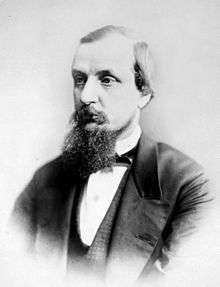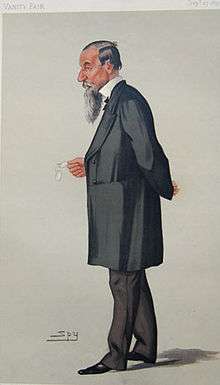Jonathan Hutchinson
| Jonathan Hutchinson | |
|---|---|
 Sir Jonathan Hutchinson | |
| Born |
23 July 1828 Selby, Yorkshire, England |
| Died |
13 June 1913 (aged 84) Haslemere, Surrey, England |
| Nationality | British |
| Known for | First physician to describe Progeria |
| Scientific career | |
| Fields |
Surgeon, ophthalmologist, dermatologist venereologist pathologist |
Sir Jonathan Hutchinson (23 July 1828 – 23 June 1913), was an English surgeon, ophthalmologist, dermatologist, venereologist and pathologist.

Life
He was born in Selby, Yorkshire, of Quaker parents and educated in the local school. Then he was apprenticed for five years to Caleb Williams, an apothecary and surgeon in York.[1]
He entered St Bartholomew's Hospital in London, and became a member of the Royal College of Surgeons in 1850 (and a Fellow in 1862), and rapidly gained reputation as a skilful operator and a scientific inquirer. While a student Hutchinson choose a career in surgery from 1854 on, under the influence and help of his mentor, Sir James Paget (1814–99). In 1851 he studied ophthalmology at Moorfields and practised it at London Ophthalmic Hospital. Other hospitals where he practised in the following years were the Lock Hospital, the City of London Chest Hospital, the London Hospital, the Metropolitan Hospitals and the Blackfriars Hospital for Diseases of the Skin.[2]
His intense activity in so many medical specialties reflected also in his involvement with several medical societies. He was president of the Hunterian Society in 1869 and 1870, professor of surgery and pathology at the Royal College of Surgeons from 1877 to 1882, president of the Pathological Society (1879–80), of the Ophthalmological Society (1883), of the Neurological Society (1887) of the Medical Society (1890), and of the Royal Medical and Chirurgical Society from 1894 to 1896. In 1889 he was president of the Royal College of Surgeons. He was a member of two Royal Commissions, that of 1881 to inquire into the provision for smallpox and fever cases in the London hospitals, and that of 1889–96 on vaccination and leprosy. He also acted as honorary secretary to the Sydenham Society.[2] In June 1882 he was elected a Fellow of the Royal Society[3]
Hutchinson is considered the father of oral medicine by some.[4]:1[5]:2
Works
Hutchinson's activity in the cause of scientific surgery and in advancing the study of the natural sciences was unwearying. He published more than 1,200 medical articles and also produced the quarterly Archives of Surgery from 1890 to 1900, being its only contributor. His lectures on neuropathogenesis, gout, leprosy, diseases of the tongue, etc., were full of original observation; but his principal work was connected with the study of syphilis, on which he became the first living authority.[2] He was the first to describe his triad of medical signs for congenital syphilis: notched incisor teeth, labyrinthine deafness and interstitial keratitis, which was very useful for providing a firm diagnosis long before the Treponema pallidum or the Wassermann test were discovered. By contrast, his insistence that leprosy was caused by eating decaying fish was incorrect.[6]
He was the founder of the Medical Graduates’ College and Polyclinic; and both in his native town of Selby and at Haslemere, Surrey, he started (about 1890) educational museums for popular instruction in natural history.[7] He published several volumes on his own subjects and was given an Hon. LL.D degree by both the University of Glasgow and University of Cambridge. He received a knighthood in 1908.
Hutchinson has his name attached to the following entities in medicine:
- Hutchinson's angina
- Hutchinson's sign
- Hutchinson's dehidrosis
- Hutchinson's disease or senile degeneration of the choroid
- Hutchinson's facies
- Hutchinson's melanotic freckle (was previously considered a precancerous spot occurring in old age, now known as melanoma in situ, lentigo maligna type)
- Hutchinson's mask
- Hutchinson's melanotic disease
- Hutchinson's patch (a corneal sign attached to syphilitic keratitis)
- Hutchinson's prurigo
- Hutchinson's pupil
- Hutchinson's teeth (seen in congenital syphilis)
- Hutchinson's triad
- Hutchinson–Gilford progeria syndrome
Later life

After his retirement from active consultative work he continued to take great interest in the question of leprosy. In one of his few scientific errors, he was firmly convinced that there was a link between getting leprosy and eating salted or rotted fish, even after the pathogenic agent, Mycobacterium leprae was discovered in 1873.
Hutchinson founded Haslemere Educational Museum in 1888.[8][9]
He died on 23 June 1913, in Haslemere, Surrey.[10] He had married Jane Pynsent West in 1856; they had six sons and four daughters. The teacher, writer and naturalist Margaret Hutchinson was his granddaughter. His son Jonathan (1859–1933) became an ophthalmic surgeon and was elected F.R.C.S. in 1884.[11][12]
Notes
- ↑ "Sir Jonathan Hutchinson" (PDF). Haslemere Museum. Archived from the original (PDF) on 17 July 2011. Retrieved 20 August 2010.
- 1 2 3 Chisholm 1911.
- ↑ "Library and Archive Catalogue". Royal Society. Retrieved 24 November 2010.
- ↑ Dayal, Promod K (1998). Textbook of medicine oral. New Delhi: Jaypee. ISBN 9788171795734.
- ↑ John, Pramod (2014). Textbook of oral medicine (3rd ed.). JP Medical Ltd. ISBN 9789350908501.
- ↑ "On Leprosy and Fish Eating a Statement of Facts and Explanations". Nature. 75 (1948): 412. 1907. doi:10.1038/075412a0.
- ↑ Klauder JV (1934). "Sir Jonathan Hutchinson". Med Life. 41: 313–27.
- ↑ "About Haslemere Educational Museum". Retrieved 20 May 2016.
- ↑ Hutchinson, Margaret (1981). A childhood in Edwardian Sussex. Hindhead: Saiga. ISBN 0862300401.
- ↑ Who's Who 1914, p. xxii; ODNB
- ↑ James, D. G. (1969). "Centenary commemoration of sarcoidosis and of Jonathan Hutchinson". British Medical Journal. 2 (5649): 109–110. doi:10.1136/bmj.2.5649.109. PMC 1982866. PMID 4887040.
- ↑ Hutchinson, Jonathan (1859–1933), Plarr's Lives of the Fellows Online
- Attribution
![]()
References
- R. J. Godlee, ‘Hutchinson, Sir Jonathan (1828–1913)’, rev. W. F. Bynum, Oxford Dictionary of National Biography, Oxford University Press, 2004. Retrieved 4 September 2007
- McKusick VA (2005). "The Gordon Wilson Lecture: The Clinical Legacy of Jonathan Hutchinson (1828–1913): Syndromology and Dysmorphology Meet Genomics". Transactions of the American Clinical and Climatological Association. 116: 15–38. PMC 1473126. PMID 16555603.
- Geraint DJ (June 2002). "Pioneers of sarcoidosis: Jonathan Hutchinson (1828–1913)". Sarcoidosis, Vasculitis and Diffuse Lung Diseases. 19 (2): 120. PMID 12102607.
- Scadding JG (November 1999). "Jonathan Hutchinson and John Hughlings Jackson: reflections on a friendship". Journal of Medical Biography. 7 (4): 224–7. PMID 11624083.
- Jackson R (July 1998). "How do physicians react to new knowledge: the experience of Jonathan Hutchinson 1828–1913 with comments on its relevance today". Journal of Cutaneous Medicine and Surgery. 3 (1): 54–6. PMID 9677263.
- Pearce JM (February 1994). "Sir Jonathan Hutchinson (1828–1913) and an early description of temporal arteritis". Journal of Neurology, Neurosurgery, and Psychiatry. 57 (2): 216. doi:10.1136/jnnp.57.2.216. PMC 1072454. PMID 8126509.
- Sharma OP (March 1993). "Arthur Conan Doyle and Jonathan Hutchinson: the sarcoidosis connection". Sarcoidosis. 10 (1): 69–70. PMID 8134721.
- Ellis H (February 1993). "Jonathan Hutchinson (1828–1913)". Journal of Medical Biography. 1 (1): 11–16. PMID 11639204.
- Oriel JD (October 1990). "Eminent venereologists 4: Jonathan Hutchinson". Genitourinary Medicine. 66 (5): 401–6. doi:10.1136/sti.66.5.401. PMC 1194566. PMID 2245990.
- Herschfeld JJ (April 1988). "Classics in dental history: Sir Jonathan Hutchinson, the universal specialist: his studies of syphilitic changes in the mouth". Bulletin of the History of Dentistry. 36 (1): 34–8. PMID 3061507.
- King DF (February 1987). "The man behind the eponym. Sir Jonathan Hutchinson. An obstinate genius". The American Journal of Dermatopathology. 9 (1): 74–5. doi:10.1097/00000372-198702000-00013. PMID 3551657.
- Sharma OP (March 1986). "Vanity Fair, Spy and Jonathan Hutchinson". Sarcoidosis. 3 (1): 75–6. PMID 3554427.
- Key JD, Mann RJ (1985). "Sir Jonathan Hutchinson, 1828–1913". Medical Heritage. 1 (2): 156. PMID 11616022.
- James DG (September 1984). "In memoriam Jonathan Hutchinson (1828–1913)". Sarcoidosis. 1 (1): 63–4. PMID 6400574.
- Jackson R (1980). "Jonathan Hutchinson on syphilis". Sexually Transmitted Diseases. 7 (2): 90–6. doi:10.1097/00007435-198004000-00012. PMID 6994262.
- Cahn LR (December 1979). "Some notes on Sir Jonathan Hutchinson (1828–1913)". The American Journal of Surgical Pathology. 3 (6): 563–6. doi:10.1097/00000478-197912000-00010. PMID 393117.
- Rook A (August 1978). "James Startin, Jonathan Hutchinson and the Blackfriars Skin Hospital". The British Journal of Dermatology. 99 (2): 215–9. doi:10.1111/j.1365-2133.1978.tb01986.x. PMID 359028.
- Greaves D (April 1978). "Sir Jonathan Hutchinson". Transactions of the Ophthalmological Societies of the United Kingdom. 98 (1): 176–7. PMID 373172.
- Henkind P (February 1978). "Jonathan Hutchinson—1828–1913". American Journal of Ophthalmology. 85 (2): 265–6. doi:10.1016/s0002-9394(14)75963-x. PMID 341713.
- Kampmeier RH (1977). "Prenatal syphilis and Sir Jonathan Hutchinson". Sexually Transmitted Diseases. 4 (4): 167–9. doi:10.1097/00007435-197710000-00012. PMID 339378.
- Schoenberg BS, Schoenberg DG (August 1977). "Eponym: the name's the same: the eponyms of Sir Jonathan Hutchinson". Southern Medical Journal. 70 (8): 993–4. doi:10.1097/00007611-197708000-00029. PMID 407656.
- Ewing M (December 1975). "Jonathan Hutchinson FRCS". Annals of the Royal College of Surgeons of England. 57 (6): 296–308. PMC 2388632. PMID 813554.
- McKusick VA (June 1971). "The 3d Conference on the clinical delineation of birth defects. Part XII. Skin, hair and nails. Dedication to the memory of Jonathan Hutchinson (1828–1913)". Birth Defects Original Article Series. 7 (8): 1–4. PMID 4950927.
- McKusick VA (June 1971). "The 3d Conference on the Clinical Delineation of Birth Defects. Part XI. Orofacial Structures. Dedication to the Memory of Jonathan Hutchinson (1828–1913)". Birth Defects Original Article Series. 7 (7): 1–2. PMID 4950921.
- Nelson CT (May 1969). "Jonathan Hutchinson on vaccination syphilis". Archives of Dermatology. 99 (5): 529–35. doi:10.1001/archderm.99.5.529. PMID 4889085.
- James DG (April 1969). "Centenary commemoration of sarcoidosis and of Jonathan Hutchinson". British Medical Journal. 2 (5649): 109–10. doi:10.1136/bmj.2.5649.109. PMC 1982866. PMID 4887040.
- Bean WB (July 1965). "JONATHAN HUTCHINSON". Archives of Internal Medicine. 116: 1–3. doi:10.1001/archinte.1965.03870010003001. PMID 14338949.
- "SIR JONATHAN HUTCHINSON (1828–1913)". JAMA: The Journal of the American Medical Association. 188: 998–9. June 1964. doi:10.1001/jama.1964.03060370054014. PMID 14132580.
- Wales AE (June 1963). "Sir Jonathan Hutchinson (1828–1913)". The British Journal of Venereal Diseases. 39 (2): 67–86. doi:10.1136/sti.39.2.i1. PMC 1047539. PMID 13998448.
- Florvaag M (June 1956). "The English physician Sir Jonathan Hutchinson; his visit to Molde hospital 1869" [The English physician Sir Jonathan Hutchinson; his visit to Molde Hospital 1869]. Tidsskrift for Den Norske Lægeforening (in Norwegian). 76 (11): 389–91. PMID 13337828.
- Schonfeld W (1953). "[Jonathan Hutchinson, 1828–1913.]". Dermatologische Wochenschrift. 127 (24): 575–6. PMID 13083073.
- McKusick VA (March 1952). "The clinical observations of Jonathan Hutchinson". American Journal of Syphilis, Gonorrhea, and Venereal Diseases. 36 (2): 101–26. PMID 14903422.
- McCleary JE, Farber EM (February 1952). "Dermatological writings of Sir Jonathan Hutchinson". AMA Archives of Dermatology and Syphilology. 65 (2): 130–6. doi:10.1001/archderm.1952.01530210009002. PMID 14884693.
- Ravitch MM (1951). "Jonathan Hutchinson and intussusception". Bulletin of the History of Medicine. 25 (4): 342–53. PMID 14859019.
External links
| Wikimedia Commons has media related to Jonathan Hutchinson. |
![]()